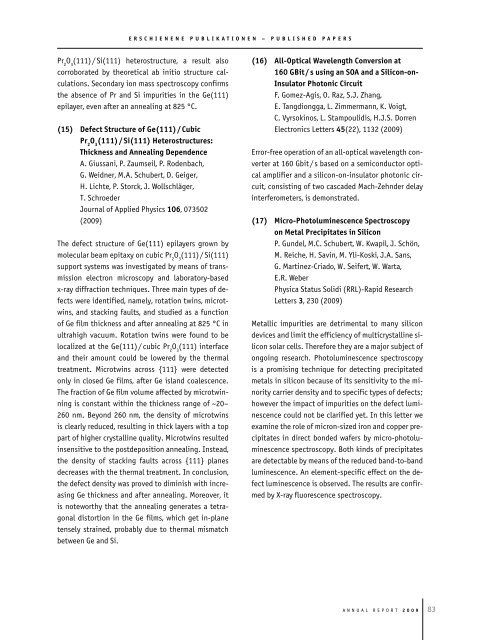Deliverables and Services - IHP Microelectronics
Deliverables and Services - IHP Microelectronics
Deliverables and Services - IHP Microelectronics
Create successful ePaper yourself
Turn your PDF publications into a flip-book with our unique Google optimized e-Paper software.
e r S C H I e N e N e p u B L I K A t I o N e N – p u B L I S H e d p A p e r S<br />
pr 2 o 3 (111) / Si(111) heterostructure, a result also<br />
corroborated by theoretical ab initio structure calculations.<br />
Secondary ion mass spectroscopy confirms<br />
the absence of pr <strong>and</strong> Si impurities in the Ge(111)<br />
epilayer, even after an annealing at 825 °C.<br />
(15) defect Structure of Ge(111) / Cubic<br />
pr 2 o 3 (111) / Si(111) Heterostructures:<br />
thickness <strong>and</strong> Annealing dependence<br />
A. Giussani, p. Zaumseil, p. Rodenbach,<br />
G. Weidner, M.A. Schubert, D. Geiger,<br />
H. lichte, p. Storck, J. Wollschläger,<br />
t. Schroeder<br />
Journal of Applied physics 106, 073502<br />
(2009)<br />
the defect structure of Ge(111) epilayers grown by<br />
molecular beam epitaxy on cubic pr 2 o 3 (111) / Si(111)<br />
support systems was investigated by means of transmission<br />
electron microscopy <strong>and</strong> laboratory-based<br />
x-ray diffraction techniques. three main types of defects<br />
were identified, namely, rotation twins, microtwins,<br />
<strong>and</strong> stacking faults, <strong>and</strong> studied as a function<br />
of Ge film thickness <strong>and</strong> after annealing at 825 °C in<br />
ultrahigh vacuum. Rotation twins were found to be<br />
localized at the Ge(111) / cubic pr 2 o 3 (111) interface<br />
<strong>and</strong> their amount could be lowered by the thermal<br />
treatment. Microtwins across {111} were detected<br />
only in closed Ge films, after Ge isl<strong>and</strong> coalescence.<br />
the fraction of Ge film volume affected by microtwinning<br />
is constant within the thickness range of ~20–<br />
260 nm. Beyond 260 nm, the density of microtwins<br />
is clearly reduced, resulting in thick layers with a top<br />
part of higher crystalline quality. Microtwins resulted<br />
insensitive to the postdeposition annealing. Instead,<br />
the density of stacking faults across {111} planes<br />
decreases with the thermal treatment. In conclusion,<br />
the defect density was proved to diminish with increasing<br />
Ge thickness <strong>and</strong> after annealing. Moreover, it<br />
is noteworthy that the annealing generates a tetragonal<br />
distortion in the Ge films, which get in-plane<br />
tensely strained, probably due to thermal mismatch<br />
between Ge <strong>and</strong> Si.<br />
(16) All-optical wavelength Conversion at<br />
160 GBit / s using an SoA <strong>and</strong> a Silicon-on-<br />
Insulator photonic Circuit<br />
F. Gomez-Agis, o. Raz, S.J. Zhang,<br />
e. tangdiongga, l. Zimmermann, K. Voigt,<br />
C. Vyrsokinos, l. Stampoulidis, H.J.S. Dorren<br />
electronics letters 45(22), 1132 (2009)<br />
error-free operation of an all-optical wavelength converter<br />
at 160 Gbit / s based on a semiconductor optical<br />
amplifier <strong>and</strong> a silicon-on-insulator photonic circuit,<br />
consisting of two cascaded Mach-Zehnder delay<br />
interferometers, is demonstrated.<br />
(17) Micro-photoluminescence Spectroscopy<br />
on Metal precipitates in Silicon<br />
p. Gundel, M.C. Schubert, W. Kwapil, J. Schön,<br />
M. Reiche, H. Savin, M. Yli-Koski, J.A. Sans,<br />
G. Martinez-Criado, W. Seifert, W. Warta,<br />
e.R. Weber<br />
physica Status Solidi (RRl)-Rapid Research<br />
letters 3, 230 (2009)<br />
Metallic impurities are detrimental to many silicon<br />
devices <strong>and</strong> limit the efficiency of multicrystalline silicon<br />
solar cells. therefore they are a major subject of<br />
ongoing research. photoluminescence spectroscopy<br />
is a promising technique for detecting precipitated<br />
metals in silicon because of its sensitivity to the minority<br />
carrier density <strong>and</strong> to specific types of defects;<br />
however the impact of impurities on the defect luminescence<br />
could not be clarified yet. In this letter we<br />
examine the role of micron-sized iron <strong>and</strong> copper precipitates<br />
in direct bonded wafers by micro-photoluminescence<br />
spectroscopy. Both kinds of precipitates<br />
are detectable by means of the reduced b<strong>and</strong>-to-b<strong>and</strong><br />
luminescence. An element-specific effect on the defect<br />
luminescence is observed. the results are confirmed<br />
by X-ray fluorescence spectroscopy.<br />
A n n u A l R e p o R t 2 0 0 9<br />
8










